100 Days Post Earthquake - Recovery Cannot Wait in Syria
UNDP in Syria Rebuilding Lives and Hope
May 14, 2023
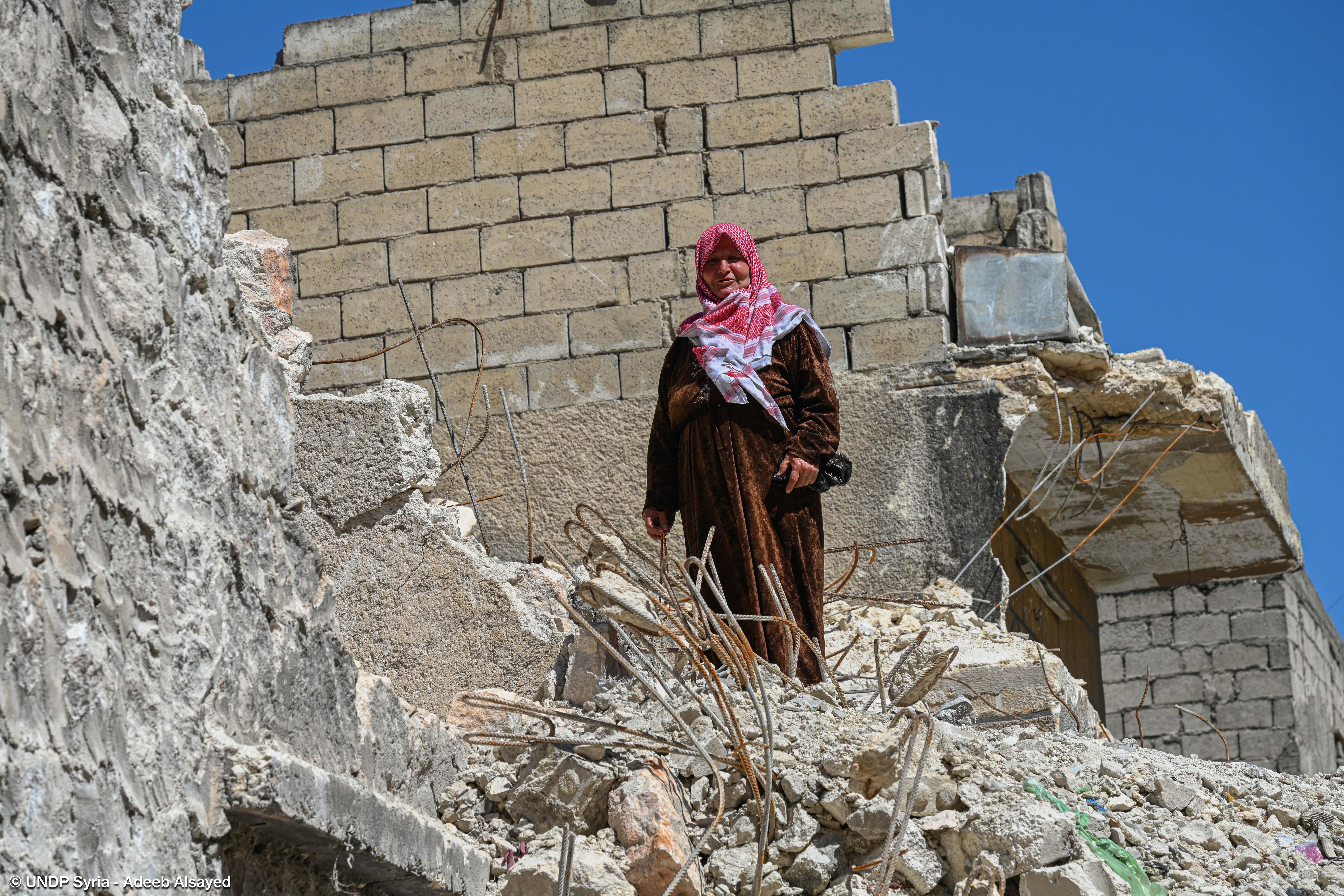
An old woman standing on the ruins of her home in Aleppo following the earthquake. She has to climb up the rubble to be able to reach what is left of her home. UNDP, with support from Japan is clearing 10,000 m3 of debris in Aleppo
On 06 February at 4:17 am, a 7.8 magnitude earthquake struck Syria and Türkiye, one of the most catastrophic the region has seen in about a century. Syria had not experienced an earthquake of this magnitude since the 1822 earthquake that devastated Aleppo City.
One hundred days have passed since the devastating earthquakes that hit northern Syria, impacting the lives of 8.8 million people in Aleppo, Hama, Idleb, Lattakia, and Tartous. The population is still trying to come to terms with the loss of lives, the trauma and destruction caused to homes and essential services, and the livelihoods destroyed. Over 470,000 remain displaced and more than 6.2 million people need protection.
The earthquake aggravated all indicators of human suffering across Syria, with 15.3 million people or 70 percent of the population in need of humanitarian assistance before the earthquake as a result of 12 years of war and displacement.
The UN-led Syria Earthquake Recovery Needs Assessment (SERNA) indicates a US$6.8 billion cost of total damage, US$2.1 billion total loss, and US$8.9 billion total effects. It is estimated that the recovery needs – if we were to take the goal of recovery to a pre-earthquake status – amount to approximately US$14.8 billion over three years.
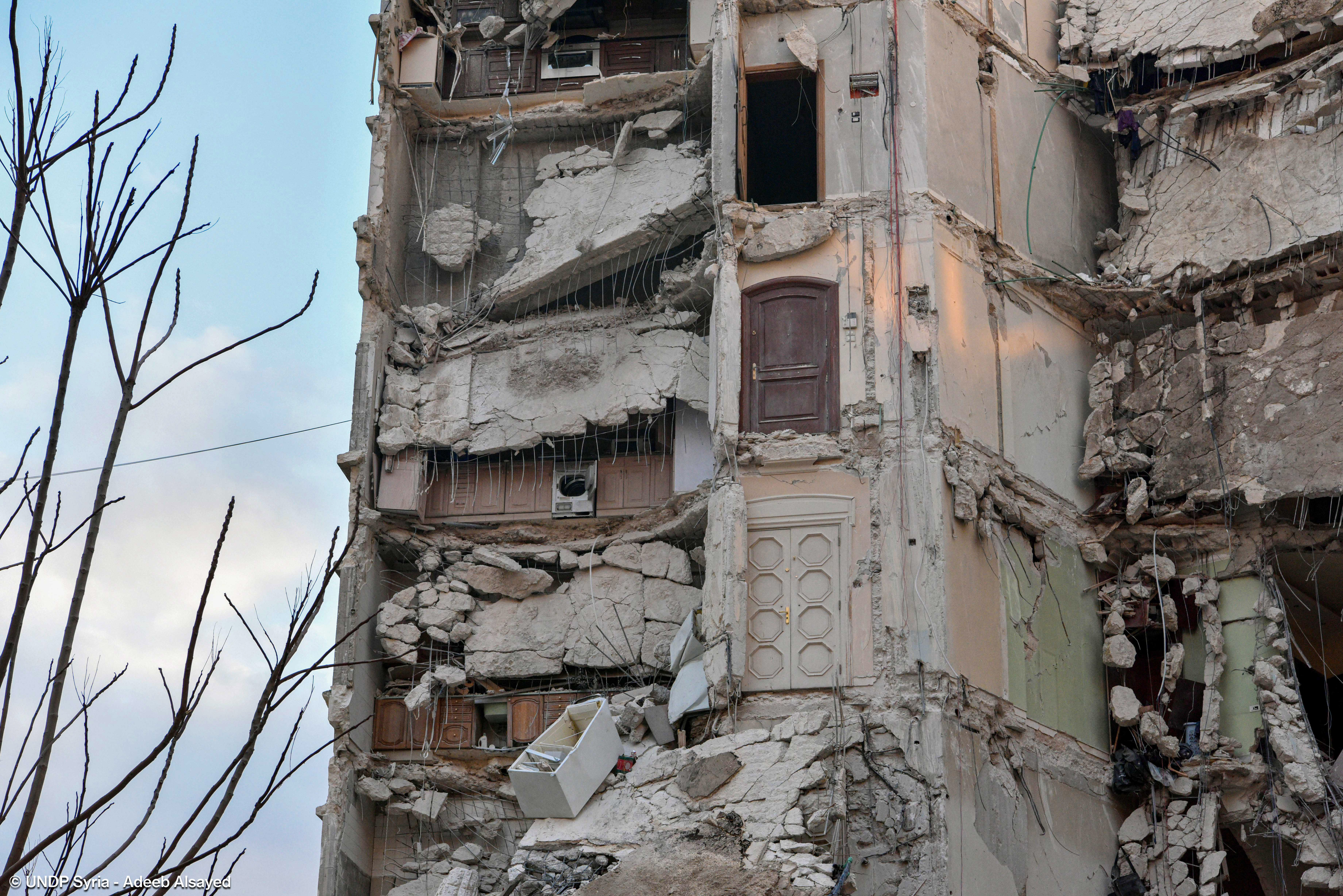
Destruction of buildings in Aleppo, Syria following the earthquake that hit Syria and Turkey on 06 February 2023
UNDP’s “Whole of Syria” early recovery approach is helping communities restore normalcy, empowering people to preserve their dignity, and strengthening delivery systems to build resilience. Our work is defined by going deeply local with our interventions and using our area-based approach to reach the most vulnerable to the best of our abilities.
Our area-based approach is placing community engagement and their priority needs at the centre of interventions; empowering people from being mere beneficiaries to active citizens engaged in their own sustainable recovery process. We are advocating for context-sensitive, multi-sectoral, multi-stakeholder, participatory approach that increases aid efficiency, effectiveness, and local ownership, while operationalizing the HDP nexus (humanitarian-development-peace) in addressing humanitarian needs in Syria.
With an initial estimated budgetary requirement of US$100 million, UNDP's response priorities focus on (1) Restoring Inclusive Access to Basic Services and Community Infrastructure, and (2) Supporting Sustainable, Dignified Livelihoods. In line with UNDP’s approach to context-sensitive recovery assistance, and to ensure doing no harm, attention will be given to risks around House Land and Property Rights (HLP), perceived fairness in the distribution of community- and household-level assistance, human-rights-informed procurement, gender-inclusivity and environmentally safe interventions.
“The most pressing need is to find proper shelter, restore basic services like water supply, sanitation and access to energy and ensure that all protection needs are adequately met. We will also need to quickly restore livelihoods through emergency jobs so that not only some sense of self-reliance is restored but also to help people heal faster by making the victims feel helpful and productive”, said Sudipto Mukerjee, UNDP Resident Representative in Syria.
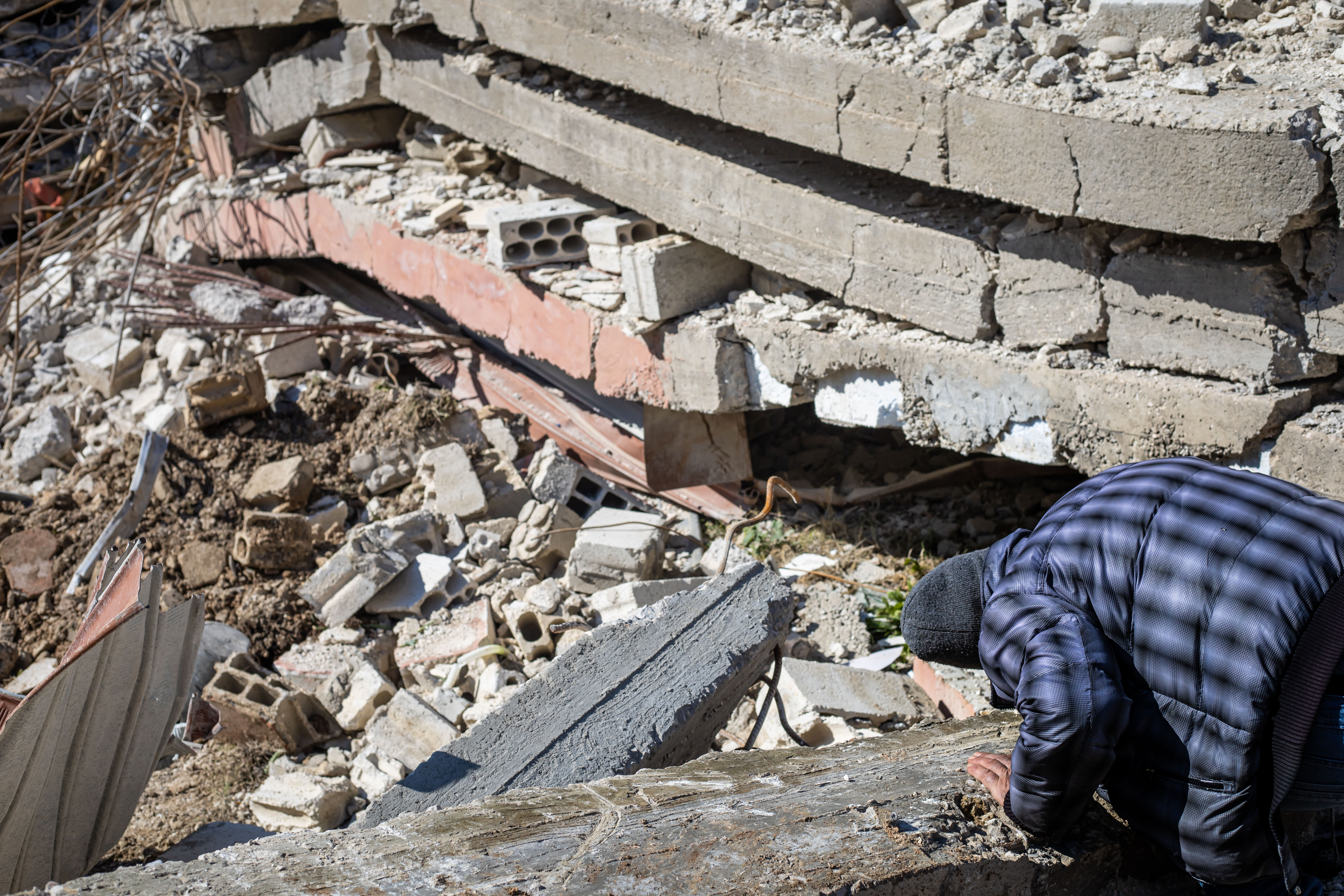
A man looking for what remains under the rubble of a destroyed building in Stamo area in Lattakia following the earthquake that hit Syria and Turkey on 06 February 2023.
UNDP worked with local actors to respond to humanitarian needs by providing shelter, food, water and healthcare, deploying specialized teams and equipment, and supporting assessments in affected areas for additional risk from damaged housing and infrastructure. While supporting local coordination, a rapid housing damage assessment was carried out, reaching around 151,000 buildings in earthquake-impacted locations.
The earthquake has added to the millions of cubic meters of debris produced across Syria due to the decade-long crisis. The newly produced debris is still blocking critical access to communities and households and is a major hurdle to the restoration of access to essential services. In some areas, the contamination of the rubble with UXO and other hazardous materials has added to the urgency for removing and disposing of it in a safe and environmentally sensitive manner.
Building upon our solid experience in debris management, UNDP is removing debris through labour-intensive techniques, and efforts will be made to salvage and reuse the debris, to the extent possible, for rehabilitation purposes. Around 137,000 m3 of debris across earthquake-impacted areas (112,000 m3 North West, 25,000 m3 Government of Syria areas) will be removed with support from the Government of Japan, SCHF and UNDP’s resources. Over 16,946 m3 of debris has been removed so far, creating 520 temporary job opportunities and improving access to over 1.9 million people. In parallel, UNDP also provided capacity building on debris removal and management, and UXOs and raised awareness on HLP rights.
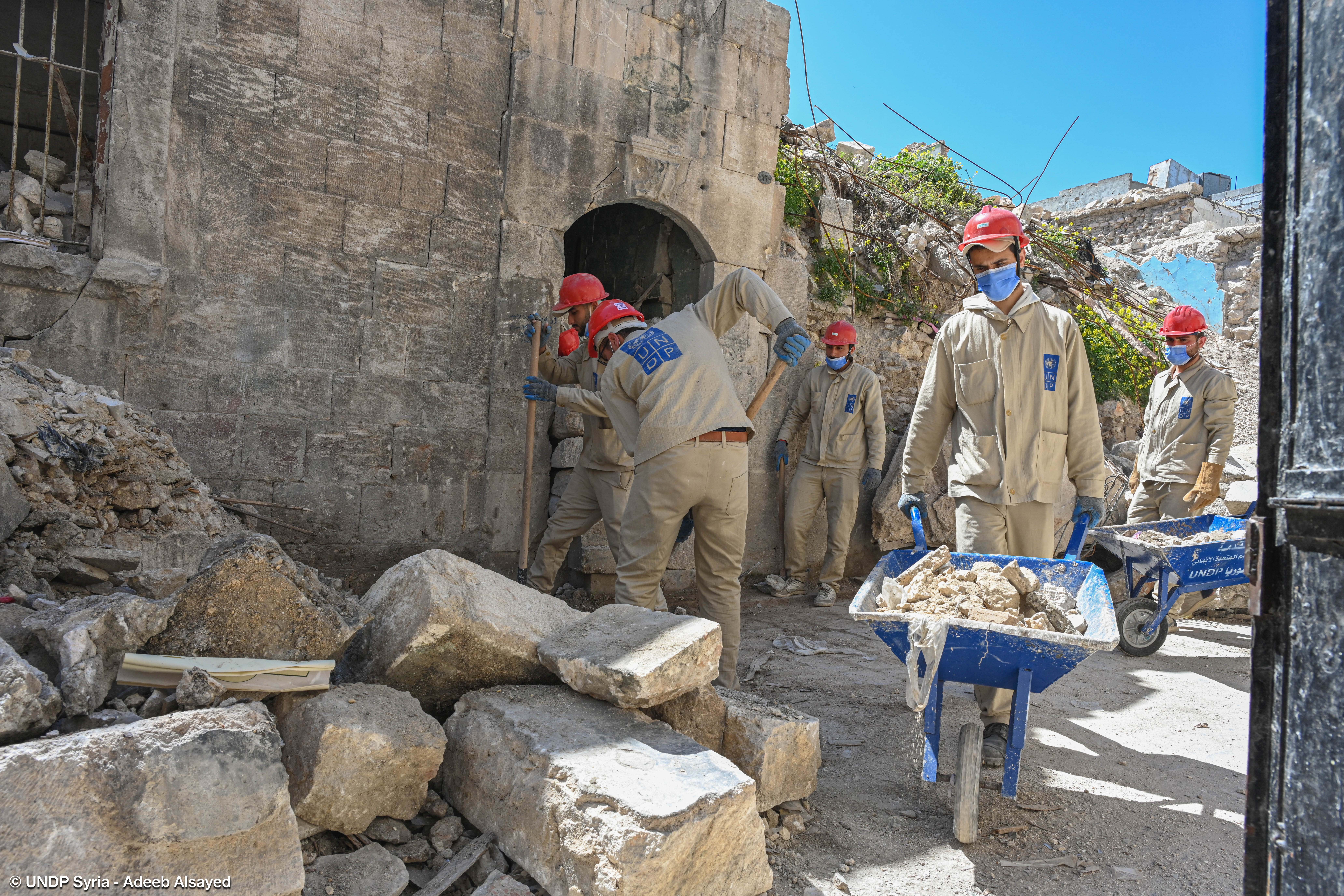
Worker removing the debris collected in Aleppo's old city. On 01 March 2023, UNDP launched its debris removal activities in Aleppo, which is one of the most impacted areas by the earthquake that hit Türkiye and Syria on 06 February 2023
To make the homes liveable, services must be restored. UNDP supported over 40,000 people so far through the provision of solar systems, lights and transformers at shelters, in addition to the restoration of access to essential services and infrastructure such as water supply, sanitation, sewerage and solid waste management through physical rehabilitation and capacity strengthening of the local level service providers.
UNDP’s jobs and livelihood interventions benefited about 6,400 people. Women’s economic empowerment projects in affected areas provided support by distributing NFIs and producing essential items, such as clothing, blankets, hygiene kits, etc. to over 715 families in need. Some even translated children’s books and produced awareness materials.
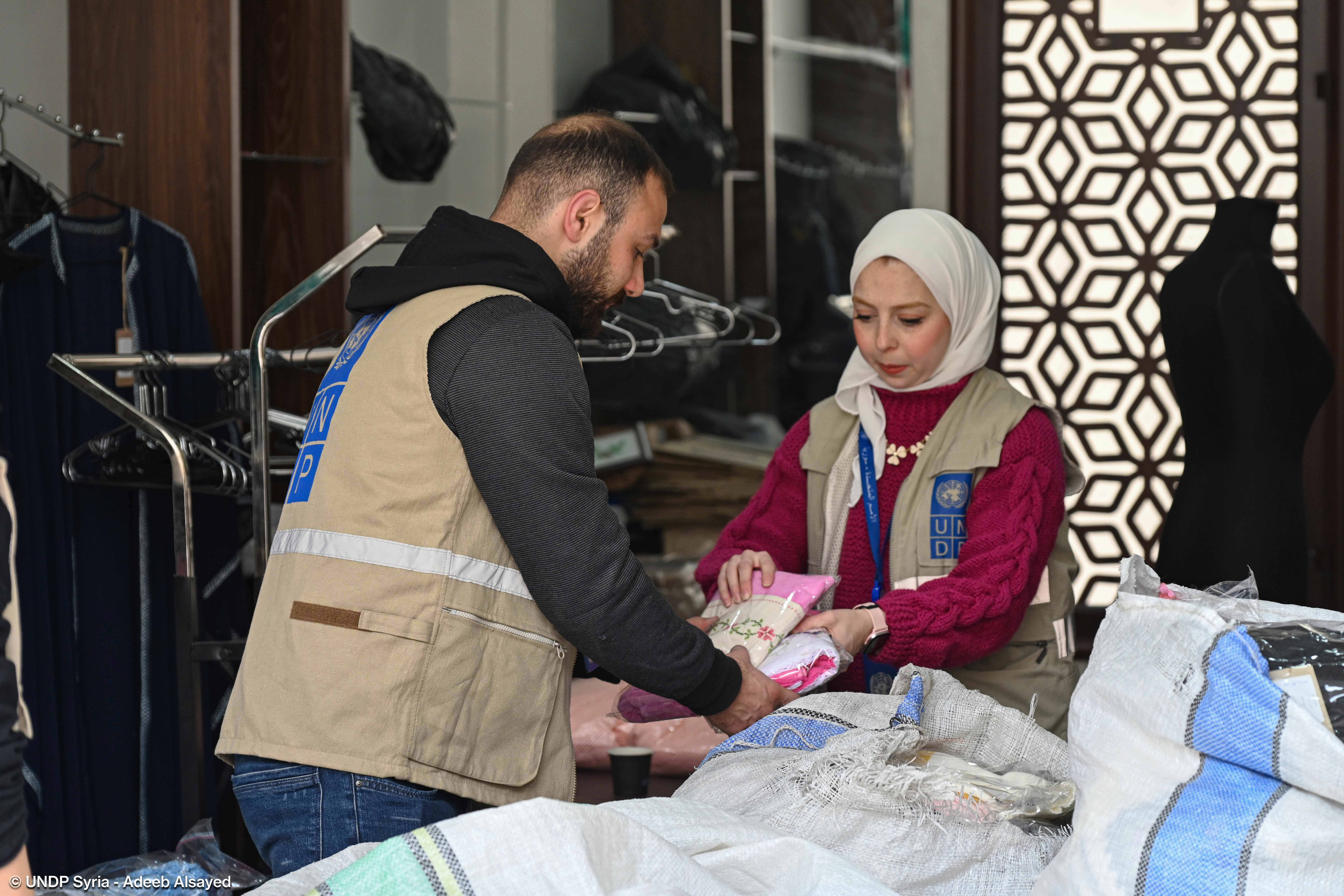
UNDP’s women economic empowerment projects in affected areas producing and distributing NFIs and essential items to over 715 families in need
UNDP is supporting the recovery of small businesses and, in turn, enhancing access to durable and dignified economic opportunities. One hundred and seventy women-led businesses and damaged MSMEs were revived with small grants, and provided with assets replacement, rental subsidies, solar light installations, etc., along with livelihood advisory and reintegration support for 120 people. Vocational training sessions were also offered in public works and other areas of specialization. Legal awareness and consultations on issues related to lost documents, inheritance, etc. reached around 400 participants, including at collective shelters.
The earthquake has exacerbated the social and psychological challenges faced by the most vulnerable members of the affected population, including women, children, the elderly, and individuals with physical and mental disabilities. UNDP is providing mental health and psychosocial support (MHPSS) through various remote and direct contact methods, ensuring aid reaches those in need. Around 3,600 people benefited from MHPSS and social protection interventions.
It is clear from the magnitude of the disaster, and the vulnerability of the people affected, that recovery will be long and difficult. UNDP will continue working with its partners to support affected people. Collective efforts from national and international partners will be needed to advance inclusive, disaster-resilient recovery. Time is of the essence, and without adequate resources and a strategic approach, many more people will require humanitarian assistance by 2024.

 Locations
Locations



